HRM80016 Leading Through Change: Managing Organization & People
VerifiedAdded on 2023/06/11
|16
|4389
|419
Essay
AI Summary
This essay provides a detailed analysis of organizational change and leadership through two case studies. The first case study examines a workplace with a poor organizational culture and ineffective change programs, highlighting challenges such as lack of communication, resistance to change, and a strict work environment. It relates these issues to Kurt Lewin's Force-Field Theory of Change and Organizational Development Theory. The second case study focuses on sexual harassment in the workplace and the subsequent changes in management and company policies implemented to address the issue. It discusses the challenges faced by the affected employee and the importance of creating a safe and supportive work environment. The essay emphasizes the significance of considering individual and group dynamics, communication, and employee involvement in successful organizational change initiatives. Desklib offers a wealth of resources including similar essays and solved assignments.
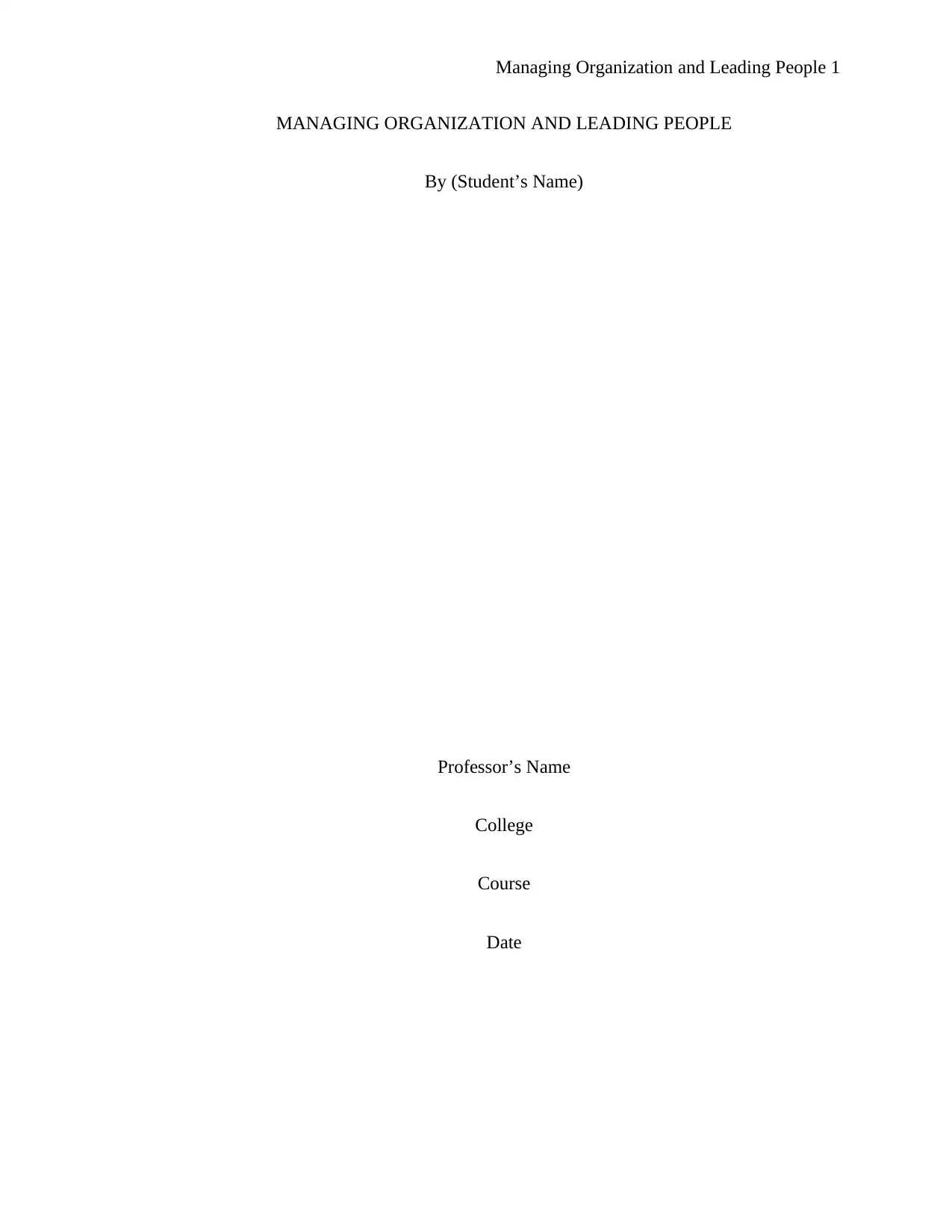
Managing Organization and Leading People 1
MANAGING ORGANIZATION AND LEADING PEOPLE
By (Student’s Name)
Professor’s Name
College
Course
Date
MANAGING ORGANIZATION AND LEADING PEOPLE
By (Student’s Name)
Professor’s Name
College
Course
Date
Paraphrase This Document
Need a fresh take? Get an instant paraphrase of this document with our AI Paraphraser
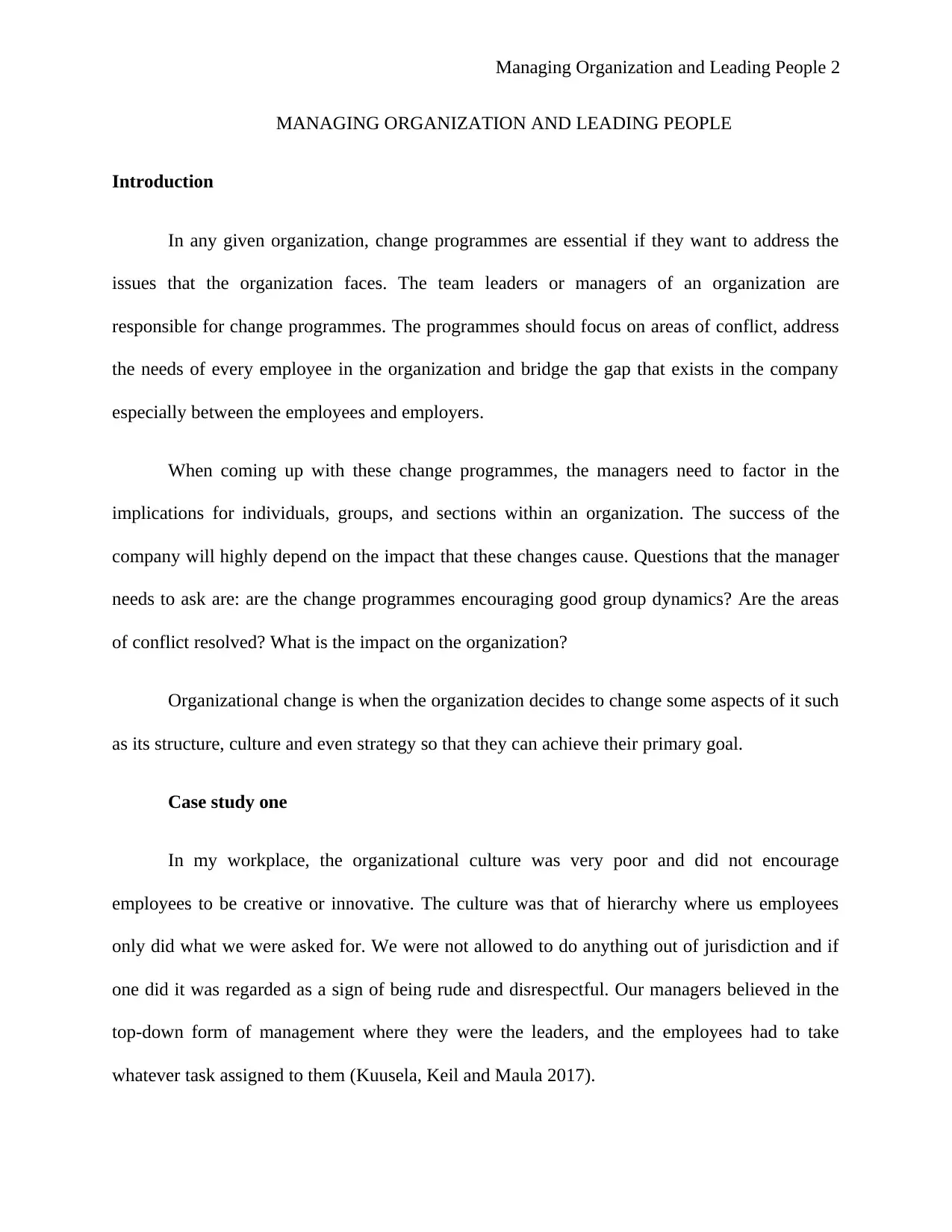
Managing Organization and Leading People 2
MANAGING ORGANIZATION AND LEADING PEOPLE
Introduction
In any given organization, change programmes are essential if they want to address the
issues that the organization faces. The team leaders or managers of an organization are
responsible for change programmes. The programmes should focus on areas of conflict, address
the needs of every employee in the organization and bridge the gap that exists in the company
especially between the employees and employers.
When coming up with these change programmes, the managers need to factor in the
implications for individuals, groups, and sections within an organization. The success of the
company will highly depend on the impact that these changes cause. Questions that the manager
needs to ask are: are the change programmes encouraging good group dynamics? Are the areas
of conflict resolved? What is the impact on the organization?
Organizational change is when the organization decides to change some aspects of it such
as its structure, culture and even strategy so that they can achieve their primary goal.
Case study one
In my workplace, the organizational culture was very poor and did not encourage
employees to be creative or innovative. The culture was that of hierarchy where us employees
only did what we were asked for. We were not allowed to do anything out of jurisdiction and if
one did it was regarded as a sign of being rude and disrespectful. Our managers believed in the
top-down form of management where they were the leaders, and the employees had to take
whatever task assigned to them (Kuusela, Keil and Maula 2017).
MANAGING ORGANIZATION AND LEADING PEOPLE
Introduction
In any given organization, change programmes are essential if they want to address the
issues that the organization faces. The team leaders or managers of an organization are
responsible for change programmes. The programmes should focus on areas of conflict, address
the needs of every employee in the organization and bridge the gap that exists in the company
especially between the employees and employers.
When coming up with these change programmes, the managers need to factor in the
implications for individuals, groups, and sections within an organization. The success of the
company will highly depend on the impact that these changes cause. Questions that the manager
needs to ask are: are the change programmes encouraging good group dynamics? Are the areas
of conflict resolved? What is the impact on the organization?
Organizational change is when the organization decides to change some aspects of it such
as its structure, culture and even strategy so that they can achieve their primary goal.
Case study one
In my workplace, the organizational culture was very poor and did not encourage
employees to be creative or innovative. The culture was that of hierarchy where us employees
only did what we were asked for. We were not allowed to do anything out of jurisdiction and if
one did it was regarded as a sign of being rude and disrespectful. Our managers believed in the
top-down form of management where they were the leaders, and the employees had to take
whatever task assigned to them (Kuusela, Keil and Maula 2017).
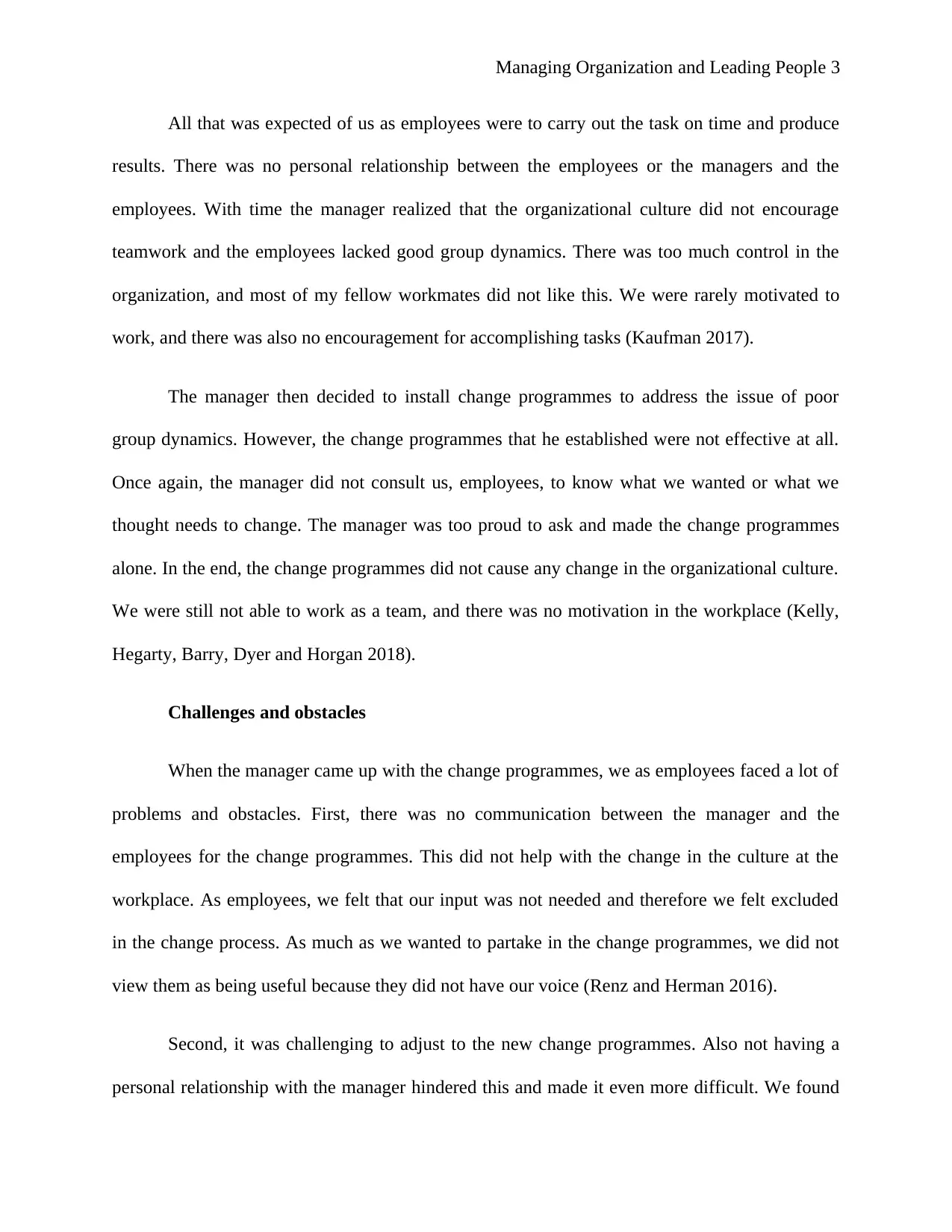
Managing Organization and Leading People 3
All that was expected of us as employees were to carry out the task on time and produce
results. There was no personal relationship between the employees or the managers and the
employees. With time the manager realized that the organizational culture did not encourage
teamwork and the employees lacked good group dynamics. There was too much control in the
organization, and most of my fellow workmates did not like this. We were rarely motivated to
work, and there was also no encouragement for accomplishing tasks (Kaufman 2017).
The manager then decided to install change programmes to address the issue of poor
group dynamics. However, the change programmes that he established were not effective at all.
Once again, the manager did not consult us, employees, to know what we wanted or what we
thought needs to change. The manager was too proud to ask and made the change programmes
alone. In the end, the change programmes did not cause any change in the organizational culture.
We were still not able to work as a team, and there was no motivation in the workplace (Kelly,
Hegarty, Barry, Dyer and Horgan 2018).
Challenges and obstacles
When the manager came up with the change programmes, we as employees faced a lot of
problems and obstacles. First, there was no communication between the manager and the
employees for the change programmes. This did not help with the change in the culture at the
workplace. As employees, we felt that our input was not needed and therefore we felt excluded
in the change process. As much as we wanted to partake in the change programmes, we did not
view them as being useful because they did not have our voice (Renz and Herman 2016).
Second, it was challenging to adjust to the new change programmes. Also not having a
personal relationship with the manager hindered this and made it even more difficult. We found
All that was expected of us as employees were to carry out the task on time and produce
results. There was no personal relationship between the employees or the managers and the
employees. With time the manager realized that the organizational culture did not encourage
teamwork and the employees lacked good group dynamics. There was too much control in the
organization, and most of my fellow workmates did not like this. We were rarely motivated to
work, and there was also no encouragement for accomplishing tasks (Kaufman 2017).
The manager then decided to install change programmes to address the issue of poor
group dynamics. However, the change programmes that he established were not effective at all.
Once again, the manager did not consult us, employees, to know what we wanted or what we
thought needs to change. The manager was too proud to ask and made the change programmes
alone. In the end, the change programmes did not cause any change in the organizational culture.
We were still not able to work as a team, and there was no motivation in the workplace (Kelly,
Hegarty, Barry, Dyer and Horgan 2018).
Challenges and obstacles
When the manager came up with the change programmes, we as employees faced a lot of
problems and obstacles. First, there was no communication between the manager and the
employees for the change programmes. This did not help with the change in the culture at the
workplace. As employees, we felt that our input was not needed and therefore we felt excluded
in the change process. As much as we wanted to partake in the change programmes, we did not
view them as being useful because they did not have our voice (Renz and Herman 2016).
Second, it was challenging to adjust to the new change programmes. Also not having a
personal relationship with the manager hindered this and made it even more difficult. We found
⊘ This is a preview!⊘
Do you want full access?
Subscribe today to unlock all pages.

Trusted by 1+ million students worldwide
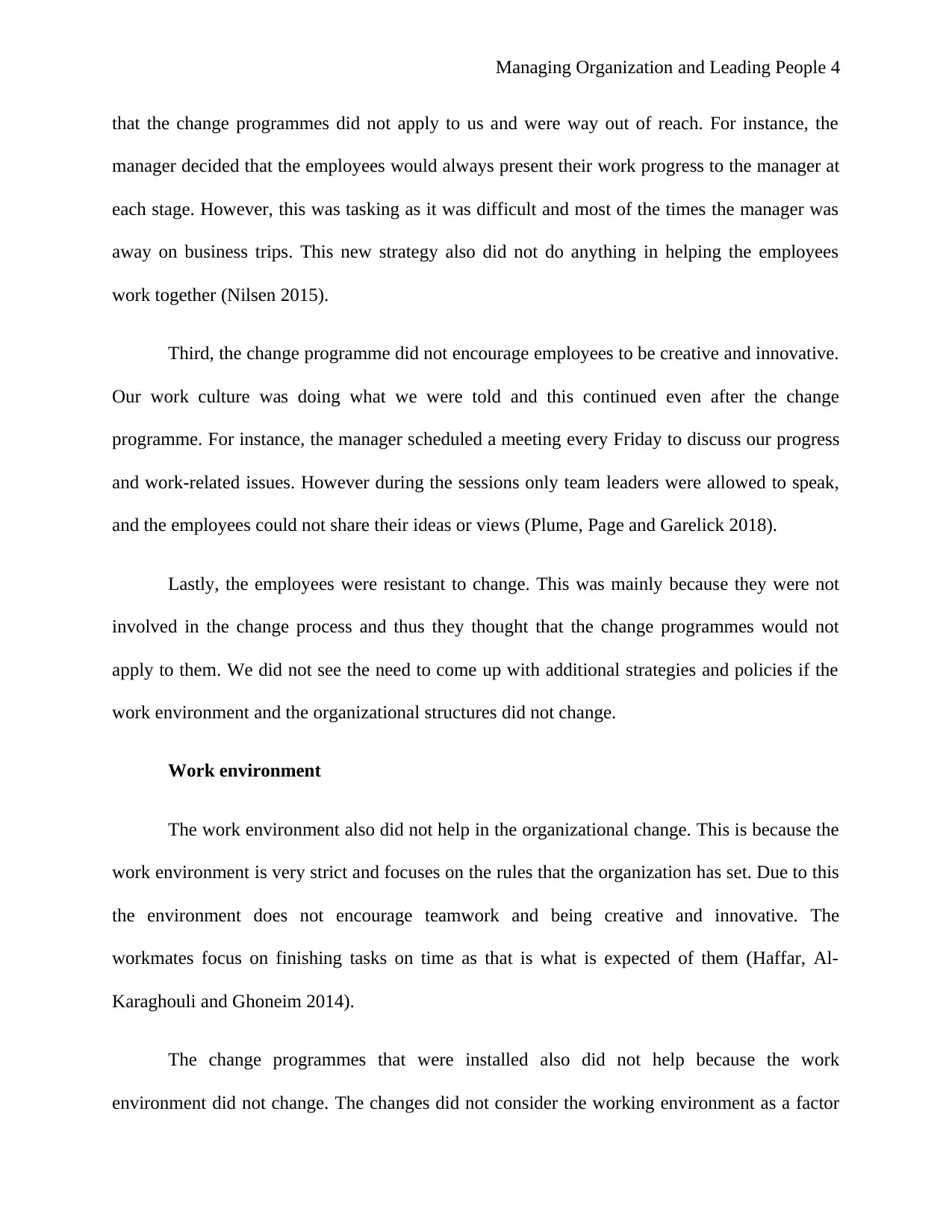
Managing Organization and Leading People 4
that the change programmes did not apply to us and were way out of reach. For instance, the
manager decided that the employees would always present their work progress to the manager at
each stage. However, this was tasking as it was difficult and most of the times the manager was
away on business trips. This new strategy also did not do anything in helping the employees
work together (Nilsen 2015).
Third, the change programme did not encourage employees to be creative and innovative.
Our work culture was doing what we were told and this continued even after the change
programme. For instance, the manager scheduled a meeting every Friday to discuss our progress
and work-related issues. However during the sessions only team leaders were allowed to speak,
and the employees could not share their ideas or views (Plume, Page and Garelick 2018).
Lastly, the employees were resistant to change. This was mainly because they were not
involved in the change process and thus they thought that the change programmes would not
apply to them. We did not see the need to come up with additional strategies and policies if the
work environment and the organizational structures did not change.
Work environment
The work environment also did not help in the organizational change. This is because the
work environment is very strict and focuses on the rules that the organization has set. Due to this
the environment does not encourage teamwork and being creative and innovative. The
workmates focus on finishing tasks on time as that is what is expected of them (Haffar, Al-
Karaghouli and Ghoneim 2014).
The change programmes that were installed also did not help because the work
environment did not change. The changes did not consider the working environment as a factor
that the change programmes did not apply to us and were way out of reach. For instance, the
manager decided that the employees would always present their work progress to the manager at
each stage. However, this was tasking as it was difficult and most of the times the manager was
away on business trips. This new strategy also did not do anything in helping the employees
work together (Nilsen 2015).
Third, the change programme did not encourage employees to be creative and innovative.
Our work culture was doing what we were told and this continued even after the change
programme. For instance, the manager scheduled a meeting every Friday to discuss our progress
and work-related issues. However during the sessions only team leaders were allowed to speak,
and the employees could not share their ideas or views (Plume, Page and Garelick 2018).
Lastly, the employees were resistant to change. This was mainly because they were not
involved in the change process and thus they thought that the change programmes would not
apply to them. We did not see the need to come up with additional strategies and policies if the
work environment and the organizational structures did not change.
Work environment
The work environment also did not help in the organizational change. This is because the
work environment is very strict and focuses on the rules that the organization has set. Due to this
the environment does not encourage teamwork and being creative and innovative. The
workmates focus on finishing tasks on time as that is what is expected of them (Haffar, Al-
Karaghouli and Ghoneim 2014).
The change programmes that were installed also did not help because the work
environment did not change. The changes did not consider the working environment as a factor
Paraphrase This Document
Need a fresh take? Get an instant paraphrase of this document with our AI Paraphraser
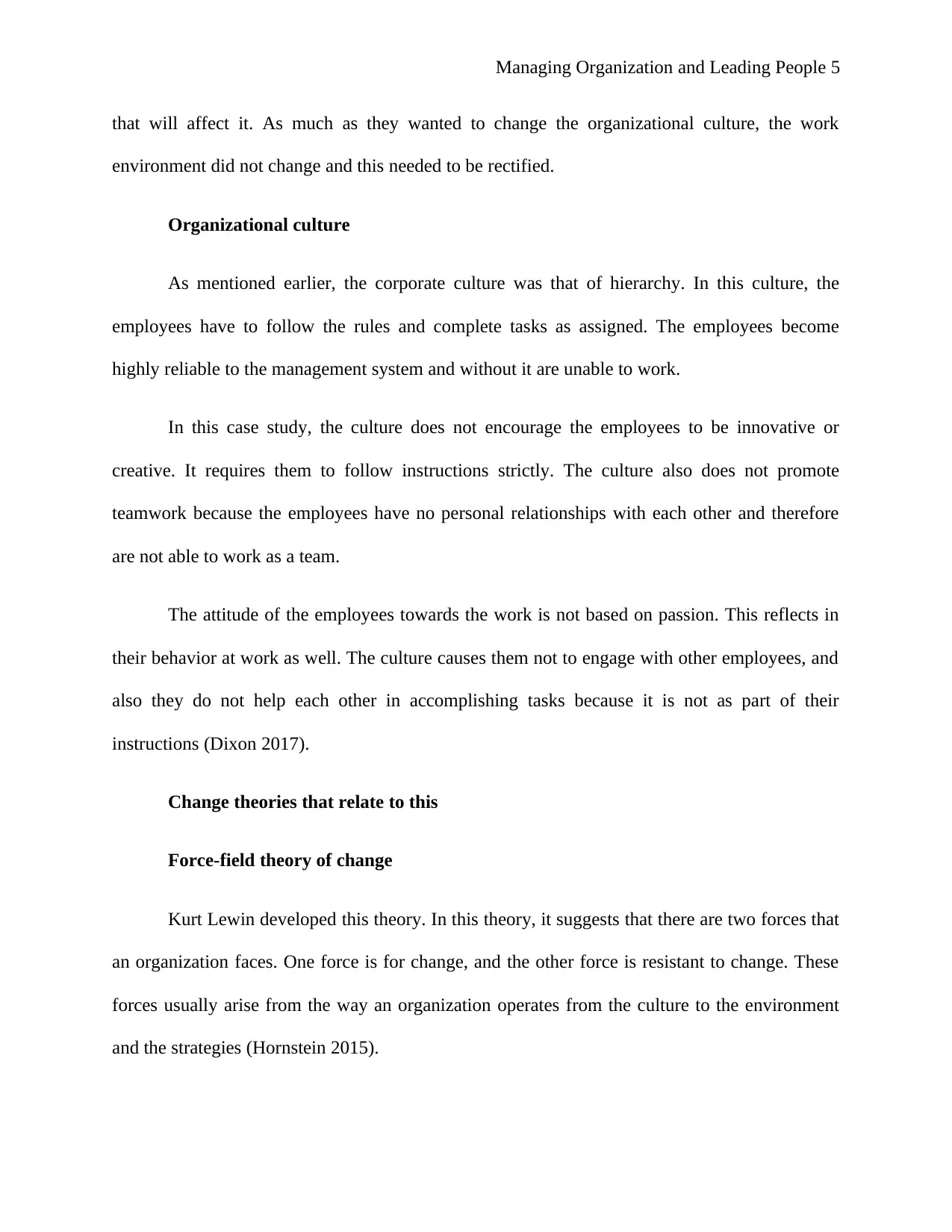
Managing Organization and Leading People 5
that will affect it. As much as they wanted to change the organizational culture, the work
environment did not change and this needed to be rectified.
Organizational culture
As mentioned earlier, the corporate culture was that of hierarchy. In this culture, the
employees have to follow the rules and complete tasks as assigned. The employees become
highly reliable to the management system and without it are unable to work.
In this case study, the culture does not encourage the employees to be innovative or
creative. It requires them to follow instructions strictly. The culture also does not promote
teamwork because the employees have no personal relationships with each other and therefore
are not able to work as a team.
The attitude of the employees towards the work is not based on passion. This reflects in
their behavior at work as well. The culture causes them not to engage with other employees, and
also they do not help each other in accomplishing tasks because it is not as part of their
instructions (Dixon 2017).
Change theories that relate to this
Force-field theory of change
Kurt Lewin developed this theory. In this theory, it suggests that there are two forces that
an organization faces. One force is for change, and the other force is resistant to change. These
forces usually arise from the way an organization operates from the culture to the environment
and the strategies (Hornstein 2015).
that will affect it. As much as they wanted to change the organizational culture, the work
environment did not change and this needed to be rectified.
Organizational culture
As mentioned earlier, the corporate culture was that of hierarchy. In this culture, the
employees have to follow the rules and complete tasks as assigned. The employees become
highly reliable to the management system and without it are unable to work.
In this case study, the culture does not encourage the employees to be innovative or
creative. It requires them to follow instructions strictly. The culture also does not promote
teamwork because the employees have no personal relationships with each other and therefore
are not able to work as a team.
The attitude of the employees towards the work is not based on passion. This reflects in
their behavior at work as well. The culture causes them not to engage with other employees, and
also they do not help each other in accomplishing tasks because it is not as part of their
instructions (Dixon 2017).
Change theories that relate to this
Force-field theory of change
Kurt Lewin developed this theory. In this theory, it suggests that there are two forces that
an organization faces. One force is for change, and the other force is resistant to change. These
forces usually arise from the way an organization operates from the culture to the environment
and the strategies (Hornstein 2015).
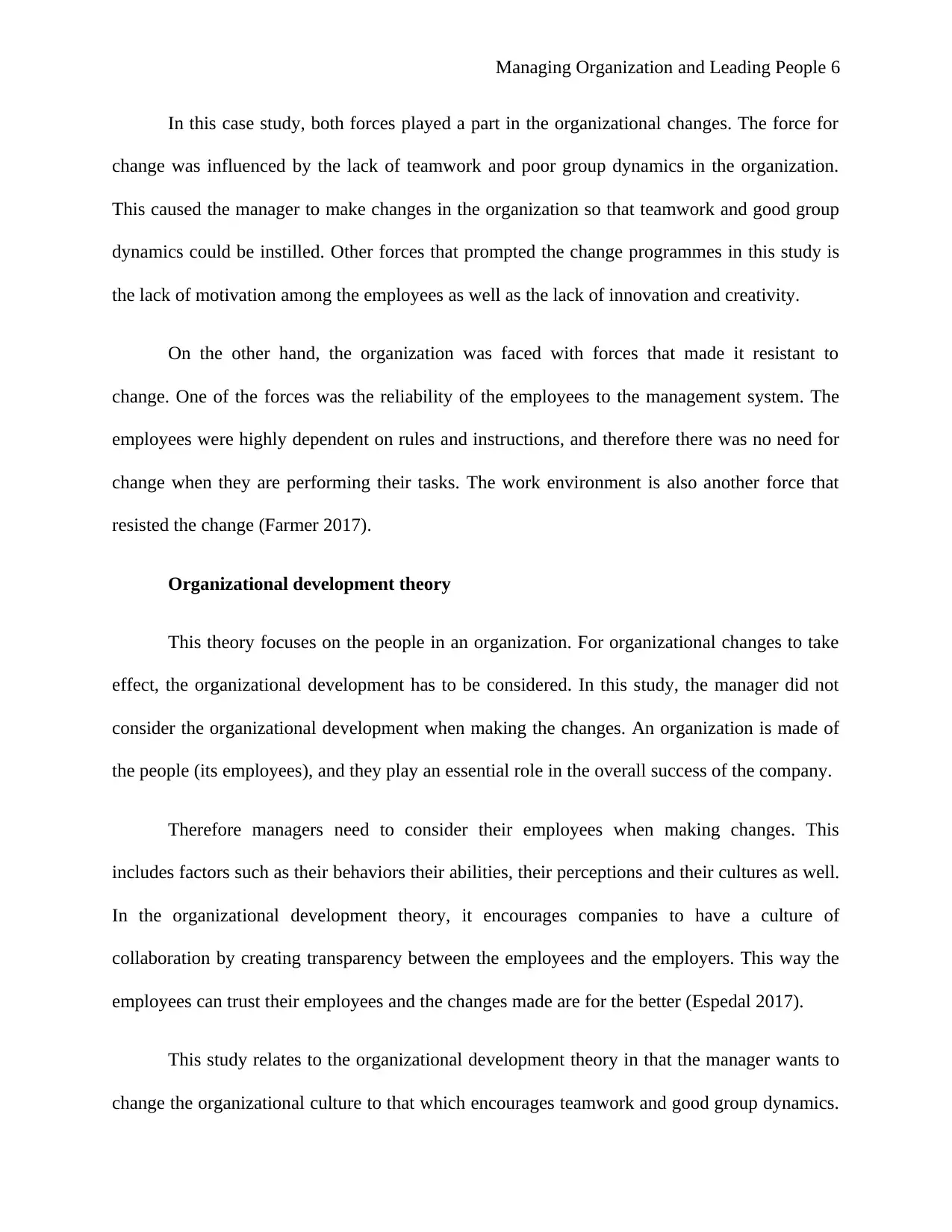
Managing Organization and Leading People 6
In this case study, both forces played a part in the organizational changes. The force for
change was influenced by the lack of teamwork and poor group dynamics in the organization.
This caused the manager to make changes in the organization so that teamwork and good group
dynamics could be instilled. Other forces that prompted the change programmes in this study is
the lack of motivation among the employees as well as the lack of innovation and creativity.
On the other hand, the organization was faced with forces that made it resistant to
change. One of the forces was the reliability of the employees to the management system. The
employees were highly dependent on rules and instructions, and therefore there was no need for
change when they are performing their tasks. The work environment is also another force that
resisted the change (Farmer 2017).
Organizational development theory
This theory focuses on the people in an organization. For organizational changes to take
effect, the organizational development has to be considered. In this study, the manager did not
consider the organizational development when making the changes. An organization is made of
the people (its employees), and they play an essential role in the overall success of the company.
Therefore managers need to consider their employees when making changes. This
includes factors such as their behaviors their abilities, their perceptions and their cultures as well.
In the organizational development theory, it encourages companies to have a culture of
collaboration by creating transparency between the employees and the employers. This way the
employees can trust their employees and the changes made are for the better (Espedal 2017).
This study relates to the organizational development theory in that the manager wants to
change the organizational culture to that which encourages teamwork and good group dynamics.
In this case study, both forces played a part in the organizational changes. The force for
change was influenced by the lack of teamwork and poor group dynamics in the organization.
This caused the manager to make changes in the organization so that teamwork and good group
dynamics could be instilled. Other forces that prompted the change programmes in this study is
the lack of motivation among the employees as well as the lack of innovation and creativity.
On the other hand, the organization was faced with forces that made it resistant to
change. One of the forces was the reliability of the employees to the management system. The
employees were highly dependent on rules and instructions, and therefore there was no need for
change when they are performing their tasks. The work environment is also another force that
resisted the change (Farmer 2017).
Organizational development theory
This theory focuses on the people in an organization. For organizational changes to take
effect, the organizational development has to be considered. In this study, the manager did not
consider the organizational development when making the changes. An organization is made of
the people (its employees), and they play an essential role in the overall success of the company.
Therefore managers need to consider their employees when making changes. This
includes factors such as their behaviors their abilities, their perceptions and their cultures as well.
In the organizational development theory, it encourages companies to have a culture of
collaboration by creating transparency between the employees and the employers. This way the
employees can trust their employees and the changes made are for the better (Espedal 2017).
This study relates to the organizational development theory in that the manager wants to
change the organizational culture to that which encourages teamwork and good group dynamics.
⊘ This is a preview!⊘
Do you want full access?
Subscribe today to unlock all pages.

Trusted by 1+ million students worldwide
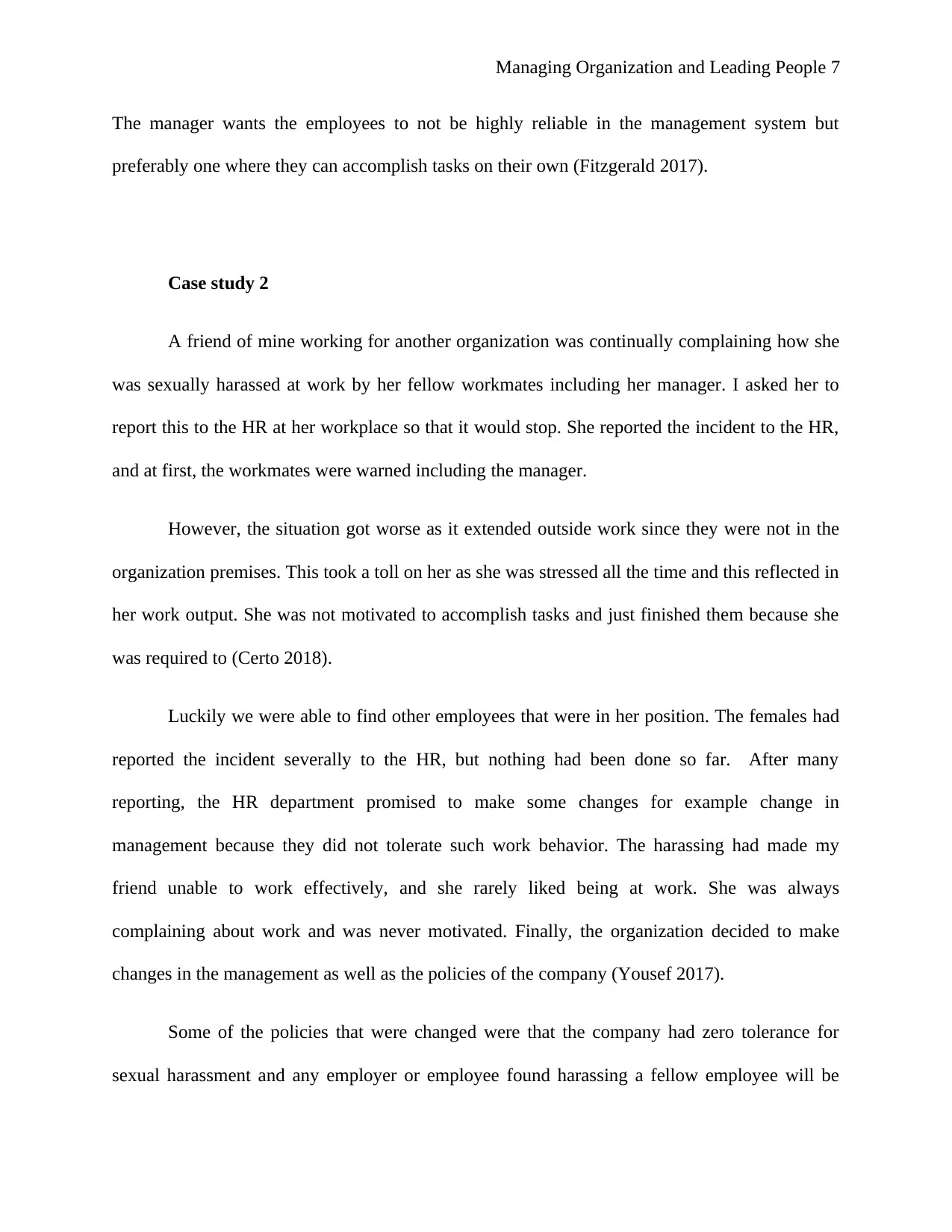
Managing Organization and Leading People 7
The manager wants the employees to not be highly reliable in the management system but
preferably one where they can accomplish tasks on their own (Fitzgerald 2017).
Case study 2
A friend of mine working for another organization was continually complaining how she
was sexually harassed at work by her fellow workmates including her manager. I asked her to
report this to the HR at her workplace so that it would stop. She reported the incident to the HR,
and at first, the workmates were warned including the manager.
However, the situation got worse as it extended outside work since they were not in the
organization premises. This took a toll on her as she was stressed all the time and this reflected in
her work output. She was not motivated to accomplish tasks and just finished them because she
was required to (Certo 2018).
Luckily we were able to find other employees that were in her position. The females had
reported the incident severally to the HR, but nothing had been done so far. After many
reporting, the HR department promised to make some changes for example change in
management because they did not tolerate such work behavior. The harassing had made my
friend unable to work effectively, and she rarely liked being at work. She was always
complaining about work and was never motivated. Finally, the organization decided to make
changes in the management as well as the policies of the company (Yousef 2017).
Some of the policies that were changed were that the company had zero tolerance for
sexual harassment and any employer or employee found harassing a fellow employee will be
The manager wants the employees to not be highly reliable in the management system but
preferably one where they can accomplish tasks on their own (Fitzgerald 2017).
Case study 2
A friend of mine working for another organization was continually complaining how she
was sexually harassed at work by her fellow workmates including her manager. I asked her to
report this to the HR at her workplace so that it would stop. She reported the incident to the HR,
and at first, the workmates were warned including the manager.
However, the situation got worse as it extended outside work since they were not in the
organization premises. This took a toll on her as she was stressed all the time and this reflected in
her work output. She was not motivated to accomplish tasks and just finished them because she
was required to (Certo 2018).
Luckily we were able to find other employees that were in her position. The females had
reported the incident severally to the HR, but nothing had been done so far. After many
reporting, the HR department promised to make some changes for example change in
management because they did not tolerate such work behavior. The harassing had made my
friend unable to work effectively, and she rarely liked being at work. She was always
complaining about work and was never motivated. Finally, the organization decided to make
changes in the management as well as the policies of the company (Yousef 2017).
Some of the policies that were changed were that the company had zero tolerance for
sexual harassment and any employer or employee found harassing a fellow employee will be
Paraphrase This Document
Need a fresh take? Get an instant paraphrase of this document with our AI Paraphraser
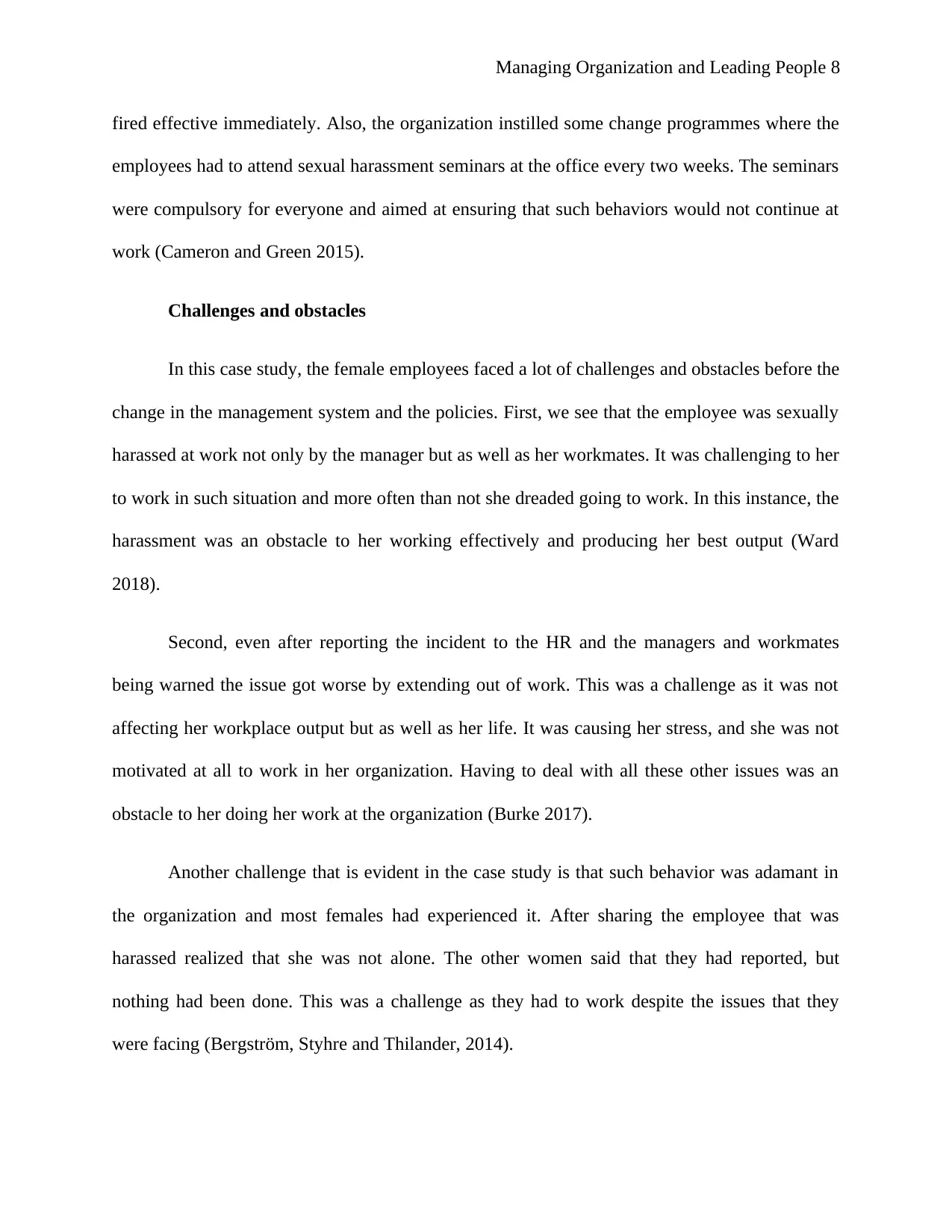
Managing Organization and Leading People 8
fired effective immediately. Also, the organization instilled some change programmes where the
employees had to attend sexual harassment seminars at the office every two weeks. The seminars
were compulsory for everyone and aimed at ensuring that such behaviors would not continue at
work (Cameron and Green 2015).
Challenges and obstacles
In this case study, the female employees faced a lot of challenges and obstacles before the
change in the management system and the policies. First, we see that the employee was sexually
harassed at work not only by the manager but as well as her workmates. It was challenging to her
to work in such situation and more often than not she dreaded going to work. In this instance, the
harassment was an obstacle to her working effectively and producing her best output (Ward
2018).
Second, even after reporting the incident to the HR and the managers and workmates
being warned the issue got worse by extending out of work. This was a challenge as it was not
affecting her workplace output but as well as her life. It was causing her stress, and she was not
motivated at all to work in her organization. Having to deal with all these other issues was an
obstacle to her doing her work at the organization (Burke 2017).
Another challenge that is evident in the case study is that such behavior was adamant in
the organization and most females had experienced it. After sharing the employee that was
harassed realized that she was not alone. The other women said that they had reported, but
nothing had been done. This was a challenge as they had to work despite the issues that they
were facing (Bergström, Styhre and Thilander, 2014).
fired effective immediately. Also, the organization instilled some change programmes where the
employees had to attend sexual harassment seminars at the office every two weeks. The seminars
were compulsory for everyone and aimed at ensuring that such behaviors would not continue at
work (Cameron and Green 2015).
Challenges and obstacles
In this case study, the female employees faced a lot of challenges and obstacles before the
change in the management system and the policies. First, we see that the employee was sexually
harassed at work not only by the manager but as well as her workmates. It was challenging to her
to work in such situation and more often than not she dreaded going to work. In this instance, the
harassment was an obstacle to her working effectively and producing her best output (Ward
2018).
Second, even after reporting the incident to the HR and the managers and workmates
being warned the issue got worse by extending out of work. This was a challenge as it was not
affecting her workplace output but as well as her life. It was causing her stress, and she was not
motivated at all to work in her organization. Having to deal with all these other issues was an
obstacle to her doing her work at the organization (Burke 2017).
Another challenge that is evident in the case study is that such behavior was adamant in
the organization and most females had experienced it. After sharing the employee that was
harassed realized that she was not alone. The other women said that they had reported, but
nothing had been done. This was a challenge as they had to work despite the issues that they
were facing (Bergström, Styhre and Thilander, 2014).
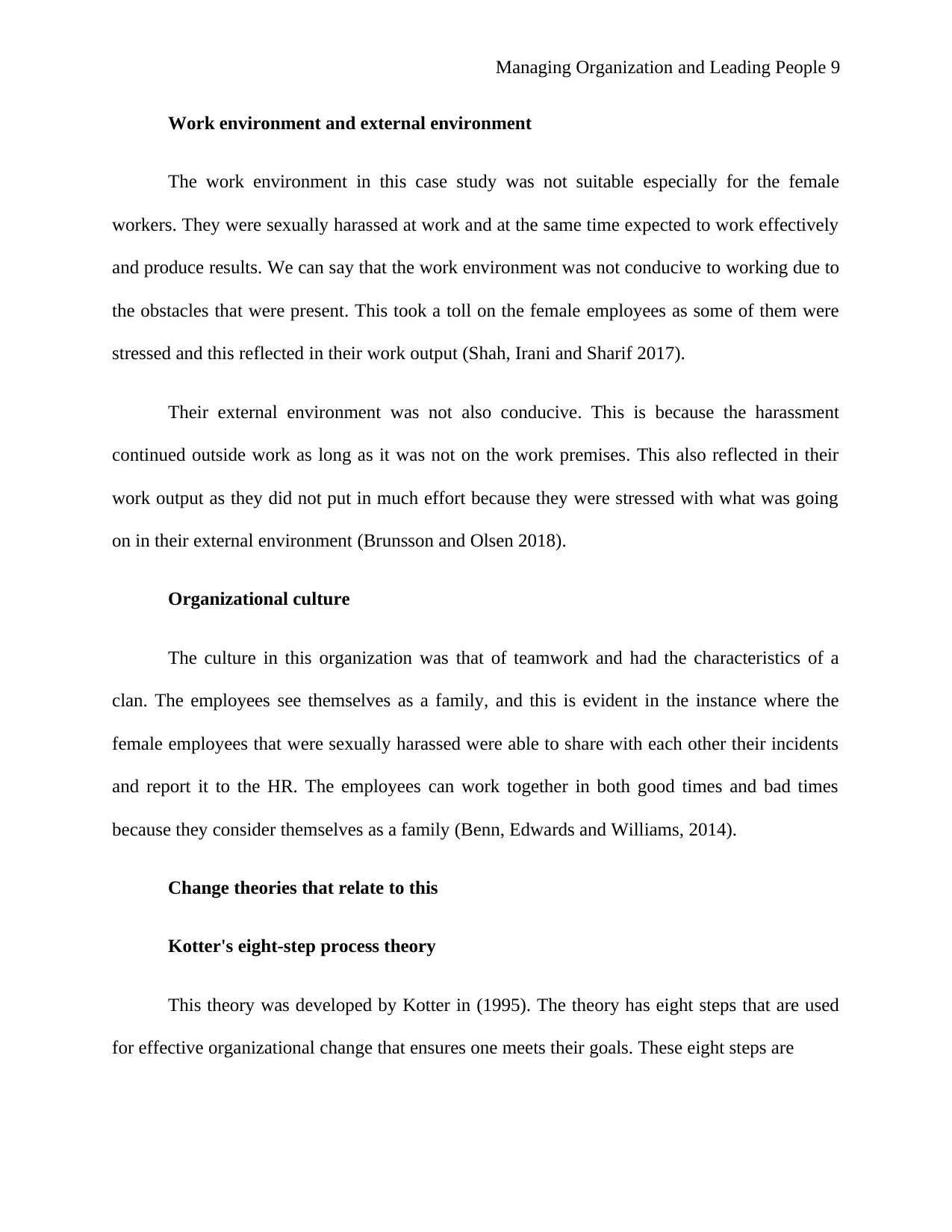
Managing Organization and Leading People 9
Work environment and external environment
The work environment in this case study was not suitable especially for the female
workers. They were sexually harassed at work and at the same time expected to work effectively
and produce results. We can say that the work environment was not conducive to working due to
the obstacles that were present. This took a toll on the female employees as some of them were
stressed and this reflected in their work output (Shah, Irani and Sharif 2017).
Their external environment was not also conducive. This is because the harassment
continued outside work as long as it was not on the work premises. This also reflected in their
work output as they did not put in much effort because they were stressed with what was going
on in their external environment (Brunsson and Olsen 2018).
Organizational culture
The culture in this organization was that of teamwork and had the characteristics of a
clan. The employees see themselves as a family, and this is evident in the instance where the
female employees that were sexually harassed were able to share with each other their incidents
and report it to the HR. The employees can work together in both good times and bad times
because they consider themselves as a family (Benn, Edwards and Williams, 2014).
Change theories that relate to this
Kotter's eight-step process theory
This theory was developed by Kotter in (1995). The theory has eight steps that are used
for effective organizational change that ensures one meets their goals. These eight steps are
Work environment and external environment
The work environment in this case study was not suitable especially for the female
workers. They were sexually harassed at work and at the same time expected to work effectively
and produce results. We can say that the work environment was not conducive to working due to
the obstacles that were present. This took a toll on the female employees as some of them were
stressed and this reflected in their work output (Shah, Irani and Sharif 2017).
Their external environment was not also conducive. This is because the harassment
continued outside work as long as it was not on the work premises. This also reflected in their
work output as they did not put in much effort because they were stressed with what was going
on in their external environment (Brunsson and Olsen 2018).
Organizational culture
The culture in this organization was that of teamwork and had the characteristics of a
clan. The employees see themselves as a family, and this is evident in the instance where the
female employees that were sexually harassed were able to share with each other their incidents
and report it to the HR. The employees can work together in both good times and bad times
because they consider themselves as a family (Benn, Edwards and Williams, 2014).
Change theories that relate to this
Kotter's eight-step process theory
This theory was developed by Kotter in (1995). The theory has eight steps that are used
for effective organizational change that ensures one meets their goals. These eight steps are
⊘ This is a preview!⊘
Do you want full access?
Subscribe today to unlock all pages.

Trusted by 1+ million students worldwide
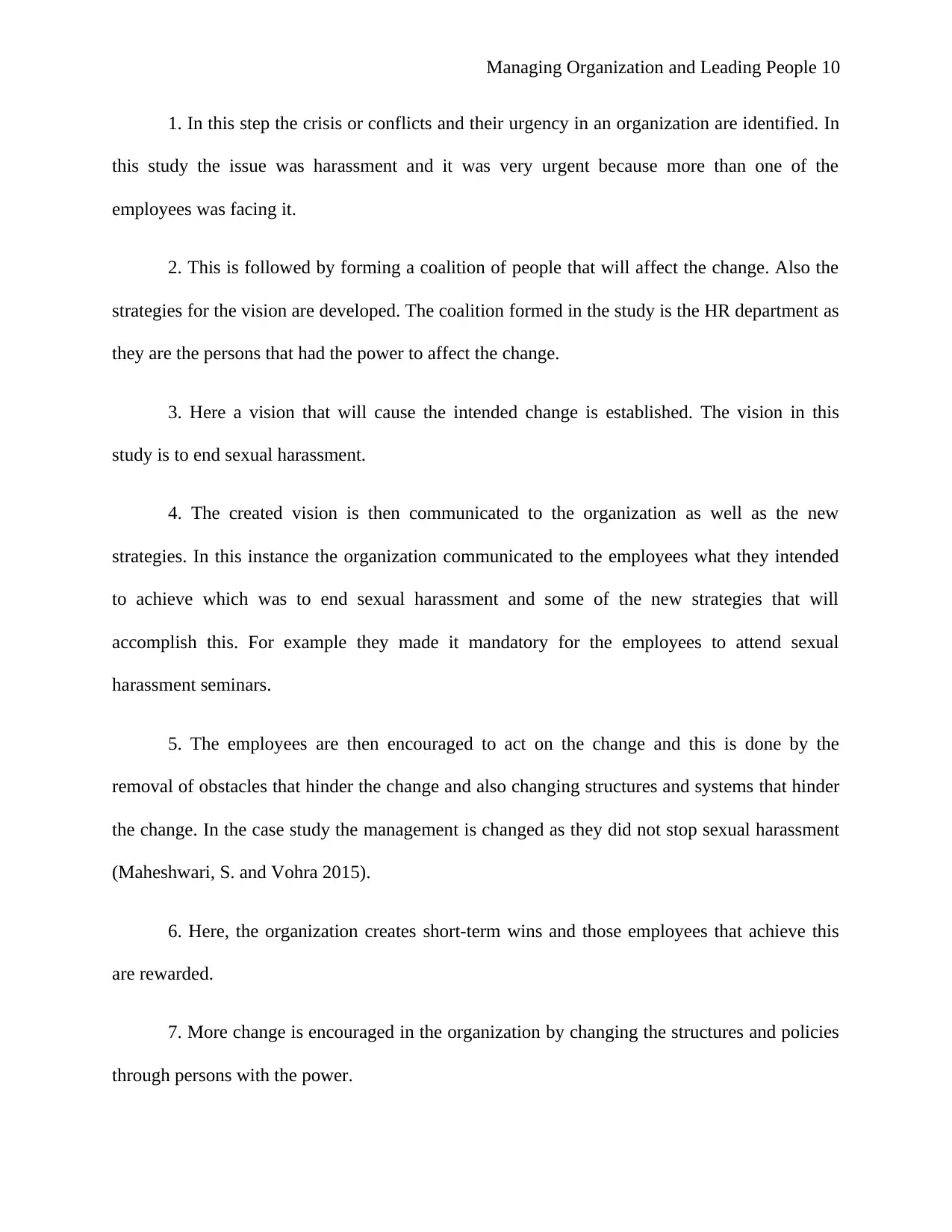
Managing Organization and Leading People 10
1. In this step the crisis or conflicts and their urgency in an organization are identified. In
this study the issue was harassment and it was very urgent because more than one of the
employees was facing it.
2. This is followed by forming a coalition of people that will affect the change. Also the
strategies for the vision are developed. The coalition formed in the study is the HR department as
they are the persons that had the power to affect the change.
3. Here a vision that will cause the intended change is established. The vision in this
study is to end sexual harassment.
4. The created vision is then communicated to the organization as well as the new
strategies. In this instance the organization communicated to the employees what they intended
to achieve which was to end sexual harassment and some of the new strategies that will
accomplish this. For example they made it mandatory for the employees to attend sexual
harassment seminars.
5. The employees are then encouraged to act on the change and this is done by the
removal of obstacles that hinder the change and also changing structures and systems that hinder
the change. In the case study the management is changed as they did not stop sexual harassment
(Maheshwari, S. and Vohra 2015).
6. Here, the organization creates short-term wins and those employees that achieve this
are rewarded.
7. More change is encouraged in the organization by changing the structures and policies
through persons with the power.
1. In this step the crisis or conflicts and their urgency in an organization are identified. In
this study the issue was harassment and it was very urgent because more than one of the
employees was facing it.
2. This is followed by forming a coalition of people that will affect the change. Also the
strategies for the vision are developed. The coalition formed in the study is the HR department as
they are the persons that had the power to affect the change.
3. Here a vision that will cause the intended change is established. The vision in this
study is to end sexual harassment.
4. The created vision is then communicated to the organization as well as the new
strategies. In this instance the organization communicated to the employees what they intended
to achieve which was to end sexual harassment and some of the new strategies that will
accomplish this. For example they made it mandatory for the employees to attend sexual
harassment seminars.
5. The employees are then encouraged to act on the change and this is done by the
removal of obstacles that hinder the change and also changing structures and systems that hinder
the change. In the case study the management is changed as they did not stop sexual harassment
(Maheshwari, S. and Vohra 2015).
6. Here, the organization creates short-term wins and those employees that achieve this
are rewarded.
7. More change is encouraged in the organization by changing the structures and policies
through persons with the power.
Paraphrase This Document
Need a fresh take? Get an instant paraphrase of this document with our AI Paraphraser
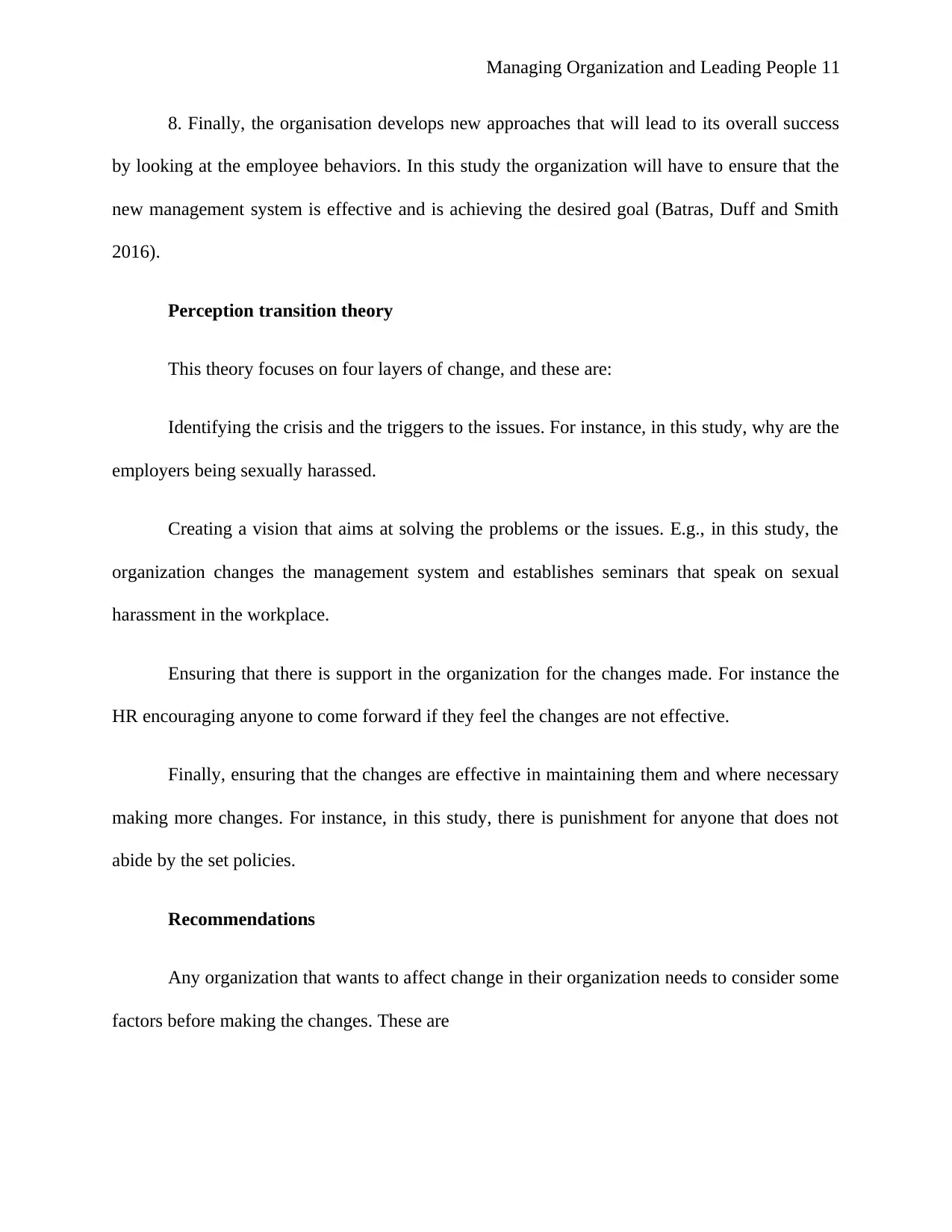
Managing Organization and Leading People 11
8. Finally, the organisation develops new approaches that will lead to its overall success
by looking at the employee behaviors. In this study the organization will have to ensure that the
new management system is effective and is achieving the desired goal (Batras, Duff and Smith
2016).
Perception transition theory
This theory focuses on four layers of change, and these are:
Identifying the crisis and the triggers to the issues. For instance, in this study, why are the
employers being sexually harassed.
Creating a vision that aims at solving the problems or the issues. E.g., in this study, the
organization changes the management system and establishes seminars that speak on sexual
harassment in the workplace.
Ensuring that there is support in the organization for the changes made. For instance the
HR encouraging anyone to come forward if they feel the changes are not effective.
Finally, ensuring that the changes are effective in maintaining them and where necessary
making more changes. For instance, in this study, there is punishment for anyone that does not
abide by the set policies.
Recommendations
Any organization that wants to affect change in their organization needs to consider some
factors before making the changes. These are
8. Finally, the organisation develops new approaches that will lead to its overall success
by looking at the employee behaviors. In this study the organization will have to ensure that the
new management system is effective and is achieving the desired goal (Batras, Duff and Smith
2016).
Perception transition theory
This theory focuses on four layers of change, and these are:
Identifying the crisis and the triggers to the issues. For instance, in this study, why are the
employers being sexually harassed.
Creating a vision that aims at solving the problems or the issues. E.g., in this study, the
organization changes the management system and establishes seminars that speak on sexual
harassment in the workplace.
Ensuring that there is support in the organization for the changes made. For instance the
HR encouraging anyone to come forward if they feel the changes are not effective.
Finally, ensuring that the changes are effective in maintaining them and where necessary
making more changes. For instance, in this study, there is punishment for anyone that does not
abide by the set policies.
Recommendations
Any organization that wants to affect change in their organization needs to consider some
factors before making the changes. These are
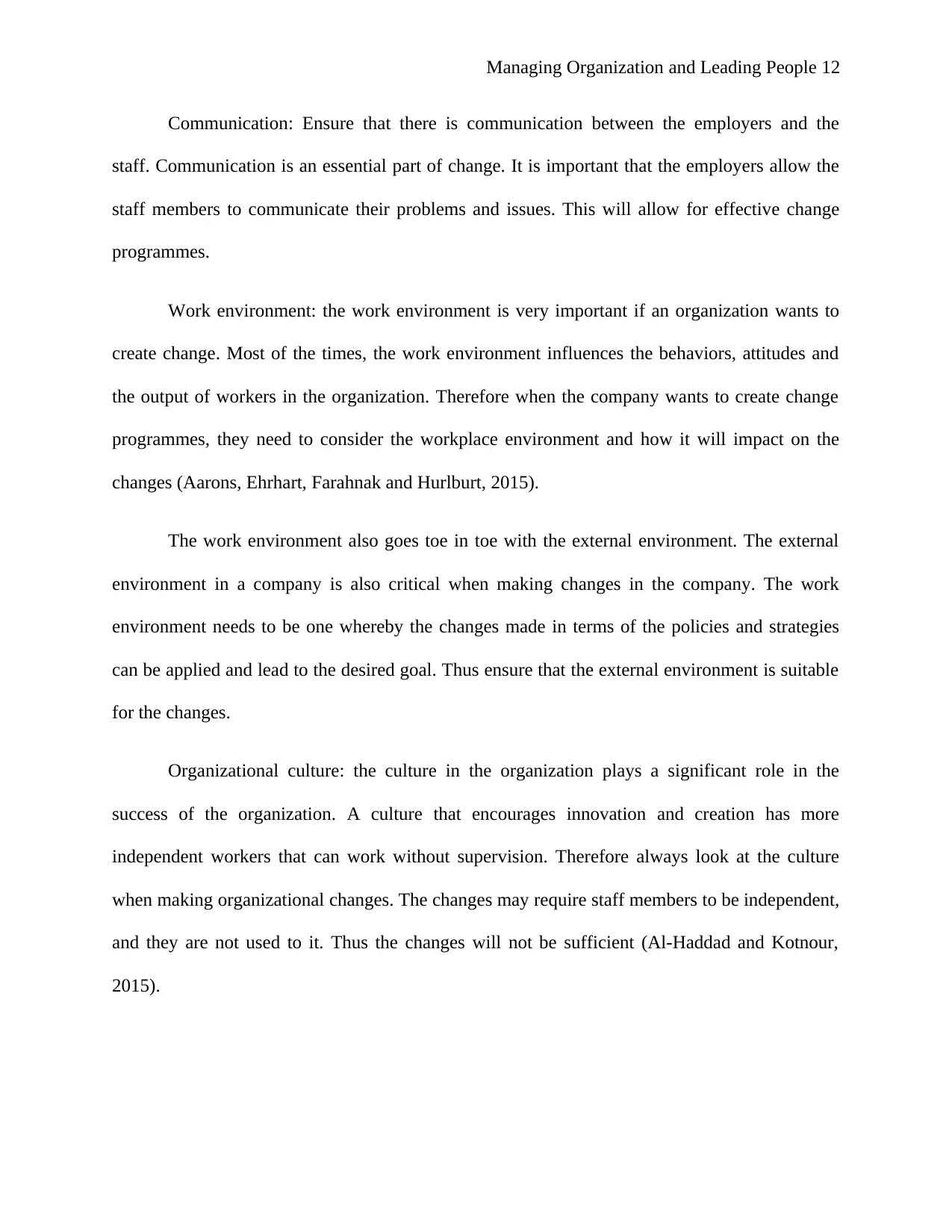
Managing Organization and Leading People 12
Communication: Ensure that there is communication between the employers and the
staff. Communication is an essential part of change. It is important that the employers allow the
staff members to communicate their problems and issues. This will allow for effective change
programmes.
Work environment: the work environment is very important if an organization wants to
create change. Most of the times, the work environment influences the behaviors, attitudes and
the output of workers in the organization. Therefore when the company wants to create change
programmes, they need to consider the workplace environment and how it will impact on the
changes (Aarons, Ehrhart, Farahnak and Hurlburt, 2015).
The work environment also goes toe in toe with the external environment. The external
environment in a company is also critical when making changes in the company. The work
environment needs to be one whereby the changes made in terms of the policies and strategies
can be applied and lead to the desired goal. Thus ensure that the external environment is suitable
for the changes.
Organizational culture: the culture in the organization plays a significant role in the
success of the organization. A culture that encourages innovation and creation has more
independent workers that can work without supervision. Therefore always look at the culture
when making organizational changes. The changes may require staff members to be independent,
and they are not used to it. Thus the changes will not be sufficient (Al-Haddad and Kotnour,
2015).
Communication: Ensure that there is communication between the employers and the
staff. Communication is an essential part of change. It is important that the employers allow the
staff members to communicate their problems and issues. This will allow for effective change
programmes.
Work environment: the work environment is very important if an organization wants to
create change. Most of the times, the work environment influences the behaviors, attitudes and
the output of workers in the organization. Therefore when the company wants to create change
programmes, they need to consider the workplace environment and how it will impact on the
changes (Aarons, Ehrhart, Farahnak and Hurlburt, 2015).
The work environment also goes toe in toe with the external environment. The external
environment in a company is also critical when making changes in the company. The work
environment needs to be one whereby the changes made in terms of the policies and strategies
can be applied and lead to the desired goal. Thus ensure that the external environment is suitable
for the changes.
Organizational culture: the culture in the organization plays a significant role in the
success of the organization. A culture that encourages innovation and creation has more
independent workers that can work without supervision. Therefore always look at the culture
when making organizational changes. The changes may require staff members to be independent,
and they are not used to it. Thus the changes will not be sufficient (Al-Haddad and Kotnour,
2015).
⊘ This is a preview!⊘
Do you want full access?
Subscribe today to unlock all pages.

Trusted by 1+ million students worldwide
1 out of 16
Related Documents
Your All-in-One AI-Powered Toolkit for Academic Success.
+13062052269
info@desklib.com
Available 24*7 on WhatsApp / Email
![[object Object]](/_next/static/media/star-bottom.7253800d.svg)
Unlock your academic potential
Copyright © 2020–2025 A2Z Services. All Rights Reserved. Developed and managed by ZUCOL.





